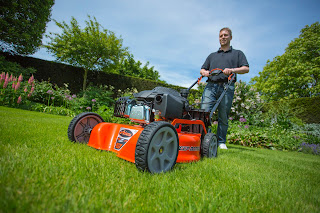Get your mower running
 For many of us the rainfall mixed with a little warmth had the grass put on a growth spurt in May but a few late frosts and cooler temperatures slowed it down again. Generally though, we’re starting to cruise around with the mower set at summer cutting height and mowing will be more frequent until we have drier conditions.
For many of us the rainfall mixed with a little warmth had the grass put on a growth spurt in May but a few late frosts and cooler temperatures slowed it down again. Generally though, we’re starting to cruise around with the mower set at summer cutting height and mowing will be more frequent until we have drier conditions.If you have a high maintenance, ornamental lawn you might apply a top-dressing of top soil. A light dressing now will help to maintain a smoother surface for mowing and help to deal with the lawn’s thatch. If there is a problem with thatch you can still lightly scarify but consider what the weather is doing and if it’s a dry spell consider irrigating after scarifying.
In periods of dry weather or prolonged drought it’s best to irrigate the lawn heavily and infrequently. Assuming you have no hosepipe ban you can water thoroughly once or twice a week. A really good soaking will penetrate deep into the soil and encourage the roots to push on down. Light sprinkling every day is a waste of water and time, only serving to encourage shallow rooting grasses. It can pay to spike the lawn as well and if you are able, switch to a mulching cut. If the weather has been hot and humid the lawn may be susceptible to brown patch fungus. Adopting a regime of watering only once a week and thoroughly will help, letting the lawn dry out in-between.
There shouldn’t be a need to apply a selective weed killer if this has already been done earlier in spring but the question of feeding does arise, and that is dependent on your type of grass. Fine-leaved fescues don’t require much fertiliser and will develop with just light feeding. Grasses with a high rye percentage such as Lolium and Agrostis, or bent species need more frequent application. However, nitrogen is required throughout the summer if you want to improve the density of the lawn but remember, too much nitrogenous fertiliser over the year can lead to excessive thatch building up, the increased possibility of disease and poor wear tolerance. It’s all a matter of balance.

Do not bother with a riding mower unless you have got at least an acre of lawn to care for. But I do advise looking into battery-powered units as an alternative to the typical mower. The battery-powered mower I review here is the best lawn mower that I have ever owned. You can find outlet a nice lawn mower from here: The Best lawn mower
ReplyDelete